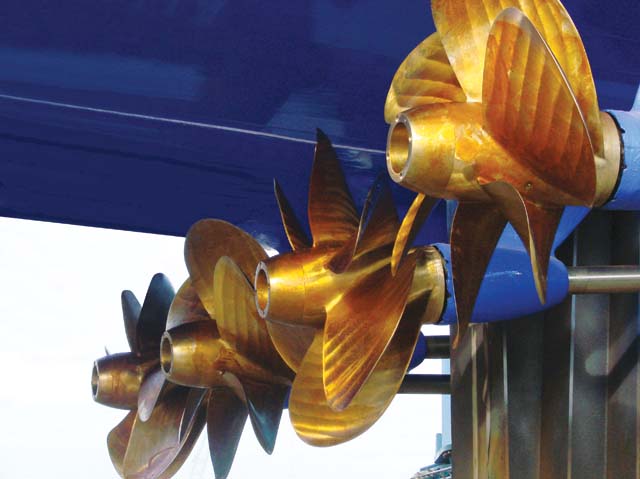Repair yard owners like what they’ve seen over the past year and expect more of the same going forward.
“We’ve been able to maintain a level of work that is significant compared to 10 years ago,” said Richard Sobocinski, a vice president with Colonna’s Shipyard Inc., a full service ship repair facility in Norfolk, Va.. “This year the commercial side has been up and the military end has been down, but that’s part of the yo-yo effect of the industry.”
For shipyards that handle repair and newbuild work, repairs have carried the load when newbuild contracts were scarce.
“Through the entire recession, we had steady repair work, but we had no newbuilds. We had plenty of work, just no new construction,” said Bette Jean Yank, marketing manager, Yank Marine Inc., Tuckahoe, N.J. “We got a newbuild contract for an 85-foot party boat in 2012. It was the first one we’d had in five or six years.”
“Today, you need diversity,” said Vigor Industrial LLC communications manager Brian Mannion. “The more diverse we are, the more we can help our customers. We handle everything from the fairly small to the really big.”
CUSTOMER SERVICE
Shipyards say it’s vitally important to understand the industry landscape and tailor a yard’s services to the customer’s needs.
After many years as a newbuild-only yard, Leevac Shipyards LLC, Jennings, La., branched out into the repair business. Leevac opened a repair yard in Lake Charles, La., in 2010 and last year purchased one of Quality Shipyards properties in Houma, La., from Tidewater Inc.
“Customers said, ‘We would like to see you get into the repair market,’ ” said Dan Gaiennie, Leevac’s vice president, business development.
The company’s 10-acre Lake Charles facility features 1,100' of bulkhead, a 40' water depth, a 3,500-ton, 300'×74' floating drydock with 64' between the wing walls, an 1,800-ton, 150'×74' floating drydock with 64' between the wing walls and two cranes. “Lake Charles we’re using as more of a deep-draft vessel repair facility,” said Gaiennie. “Houma will handle the more traditional workboats.”
Vigor operates a shipyard in Portland, Ore., and also owns and operates the former Todd Shipyards in Seattle and the former Alaska Ship & Drydock in Ketchikan, Alaska. In August, the 960'×228'×70', $50 million Vigorous, which Vigor says is the largest floating drydock in the U.S., arrived at the company’s Portland facility. The Vigorous has an 80,000-LT capacity and 186' between the wing walls. “It’s about growing. It’s about having all that capacity,” said Mannion. The new drydock should be in service by Nov. 1.
Colonna’s is located about two miles from the Norfolk Naval Shipyard and 10 miles from the U.S. Naval Station in Norfolk. The yard sits on 70 acres of land, with water access to over 3,000' of vessel/boat berthing space and lift capacity to accommodate vessels up to 850'×89'×29'. “I can’t do the naval carriers, but I can do the naval carrier shafts,” said Sobocinski. “We’ve almost quadrupled our shop size because of it. I’ve got 25 shafts in line now for component repair.”
Sobocinski said when it comes to some of the Navy ships, his workers have to go where the work is because the ships are too big to come to Colonna’s. “We’ve got over 100 people working at other shipyards,” he said.
Colonna’s took delivery of the world’s largest mobile boat hoist from Marine Travelift in 2010, the 1,000-ton-capacity 1000C. “We spent $6 million for that Travelift, but the payback is that there’s a lot of work we wouldn’t have gotten without it.”
Yank Marine has seven berthing areas from 65' to 100' and 18,000 sq. ft. of enclosed building space for the repair of vessels up to 150'. “We do a lot of repair work for New York Waterway,” said Yank. “We’ve also done quite a lot of work for Great Lakes Dredging. So we’ve been busy.”
LABOR ISSUE
Repair facilities face the same personnel concerns as newbuild yards. “The tough part when it comes to personnel is you’re not just competing against other yards in your area,” said Sobocinski, “you’re competing against other industries.”
Colonna’s partners with a community college to train newcomers to the industry. “We’re seeing more interest in shipyard jobs. These are good paying jobs, and we provide the training,” said Sobocinski. “We have 30 spots open in our current training program and 120 applicants. The ones who make the program have to be committed. They work a full day at the yard then several times a week they have to go to class after that.”
Mannion said that more opportunity exists for workers at Vigor because they have so many yards and work on so many different types of vessels. “As far as personnel is concerned, we’re doing pretty well,” he said. “We cross train to create more stability. We’re asking our folks to diversify.”
In the Gulf, there’s strong demand from the largest concentration of workboat shipyards in the U.S. “Labor in that market is very difficult,” said Gaiennie. “Getting labor for a second shift, for example, is difficult.”





